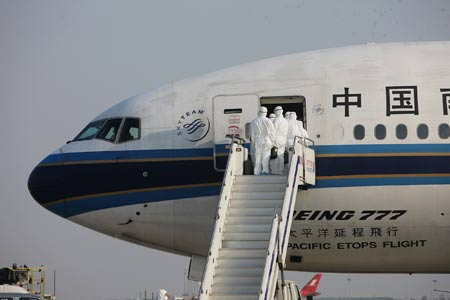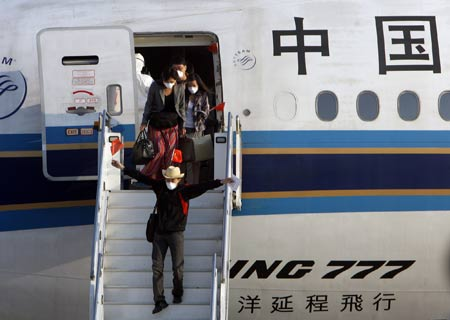|
Chinese Plane Brings Back Nationals from Mexico
A plane sent to fetch 98 Chinese citizens from Mexico arrived in Shanghai Wednesday afternoon. All on board were in normal condition, the city's quarantine bureau said.
The plane landed at Pudong International Airport at 4:32 p.m. The passengers, along with a Shanghai-based infectious disease specialist who accompanied them, were sent to a hotel for quarantine.
China sent the flight under an agreement with Mexico, which has been battling an A/H1N1 flu outbreak, to send back each other's nationals.
Checks by quarantine officials showed that the passengers and the specialist, Lu Hongzhou, had normal body temperatures.
 |
| Inspectors walk aboard the chartered plane from Mexico to check the health of Chinese citizens from Mexico after the plane arrived in Shanghai on May 6, 2009. The chartered plane sent to fetch Chinese citizens from Mexico arrived in Shanghai Wednesday afternoon, with 98 passengers and 21 crew members on board. |
Lu told Xinhua by telephone that his mission was to treat passengers if they took sick en route and make sure the disease did not spread on the plane.
"We prepared plenty of medicine and instruments and made a detailed response plan," he added.
The passengers wore new surgical masks every four hours and had meals by turns during the flight. They also were told to wash hands regularly.
Each of the passengers received a letter of apology and a Shanghai World Expo mascot, Haibao.
The Shanghai Quarantine Bureau checked the health of all the people on the plane on its arrival, and sterilized the aircraft, luggage and waste.
The China Southern Airlines plane flied on to Guangzhou, headquarters of the flight operator, where the 19 crew members would be under observation.
The plane picked up 79 Chinese nationals in Mexico City and 19 others in Tijuana. They are from 15 provinces and municipalities, including Shanxi, Guangdong and Beijing, and most of them are business people.
The flight left Guangzhou for Mexico Monday night and was expected to return to China on Wednesday morning but was delayed by bad weather in Tijuana.
China suspended direct flights from Mexico to Shanghai starting Saturday after a 25-year-old Mexican, who arrived in Shanghai last Thursday on board flight Aeromexico 098, was later diagnosed with A/H1N1 flu in Hong Kong and put into quarantine.
 |
| Passengers go off from the chartered plane from Mexico after the plane arrived at Pudong International Airport in Shanghai, east China, May 6, 2009. |
China's Ministry of Health said Wednesday that passengers on the mainland who took the same flight with the Mexican man will be out of quarantine Thursday if they display no flu-like symptoms.
Vice Health Minister Zhang Mao warned that China faces a growing risk of the influenza A/H1N1 spreading into its mainland although new cases worldwide increase at slower rate.
The Chinese central government Tuesday pledged to earmark 5 billion yuan (725 million U.S. dollars) for the A/H1N1 flu prevention and control.
In the past week, China has initiated a joint prevention and control mechanism, adopted strict quarantine of people, goods and vehicles entering its border, stepped up epidemic monitoring and made active medical preparations for emergencies.
(Source: Xinhua)
| 